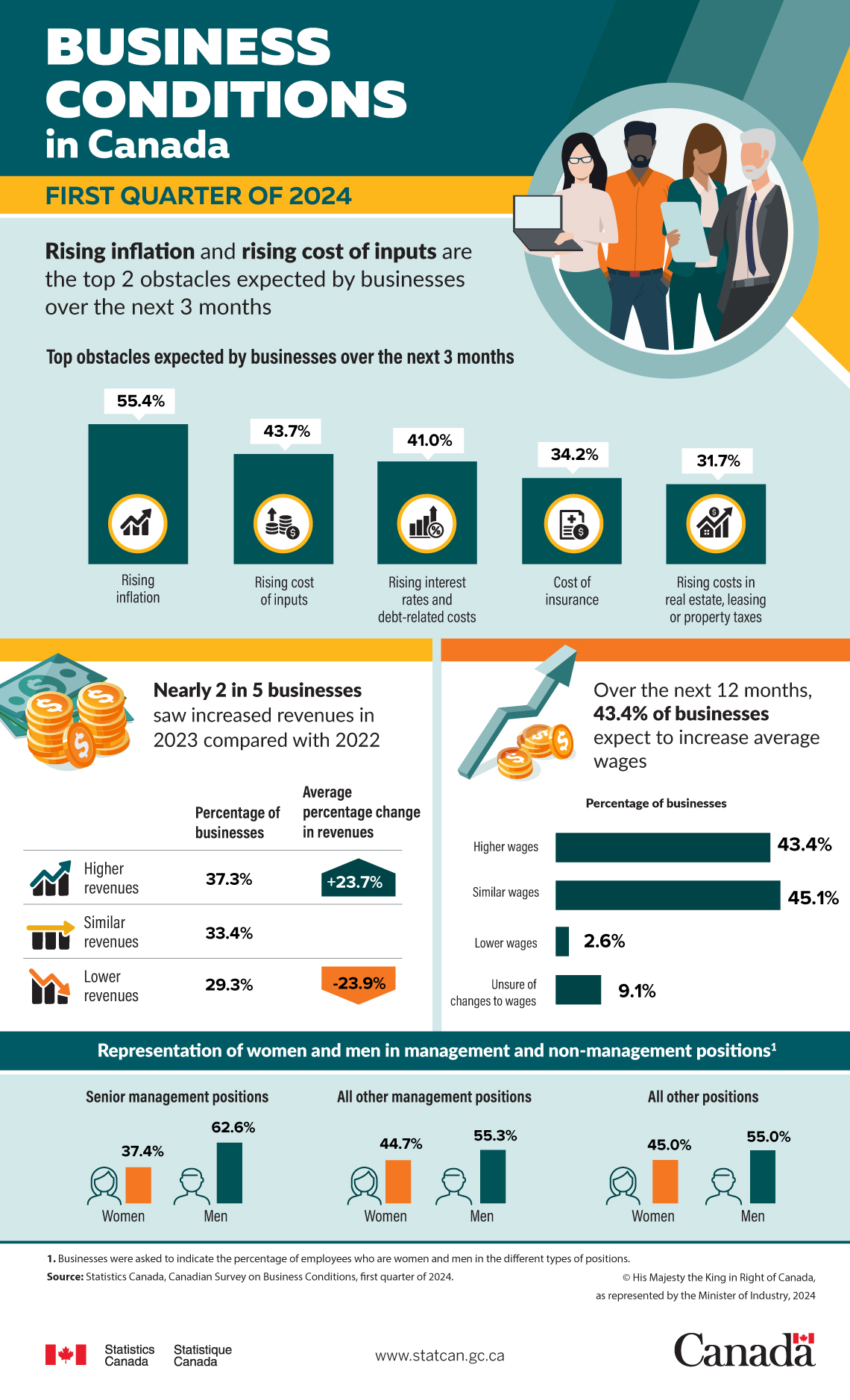The Business and Community Newsletter – March 2024
Release date: March 21, 2024

Feature article
Defining and measuring the gig economy using survey data: Gig work, digital platforms, and dependent self-employment
In the fourth quarter of 2022, 871,000 Canadians did gig work in their main job
As gig work consists of short-term tasks or paid activities, it can also be done sporadically and does not always represent a main job or business. In October, November and December 2022, an additional 1.5 million people on average reported having done freelancing, paid gigs or short-term jobs or tasks at some point during the previous 12 months.
In 2023, close to half a million people worked through a digital platform or app which also paid them for their work
In the modern workplace, workers are increasingly using a range of online tools, platforms and apps. These apps and platforms range from videoconferencing software to social media and have transformed the way many Canadians work or operate their business.
StatsCan App

Prefer accessing data at your fingertips? Download the StatsCAN mobile app from Google Play or the App Store to tap into expert analysis, visuals and the latest statistical news right from the source!
Canadian business counts, December 2023
In December, there were 1.35 million employer businesses in Canada and 3.24 million non-employer businesses with annual revenues greater than $30,000.
The Canadian business counts are available for each province and territory, as well as for every census metropolitan area (CMA) and the census subdivisions (CSDs) within them. Counts are also available for CSDs that are not part of CMAs, provided they have 10 or more active businesses with employees.
Check out the data Canadian Business Counts, with employees, December 2023
Labour Force Survey, February 2024
Employment rose by 41,000 in February. The employment rate fell by 0.1 percentage points to 61.5%, as population growth (+0.3%) continued to outpace employment growth (+0.2%).
The unemployment rate increased 0.1 percentage points to 5.8%, offsetting a decline in January.
Employment increased among core-aged (25 to 54 years old) women (+45,000; +0.7%) and men (+23,000; +0.3%). At the same time, there were fewer women aged 55 and older employed (-29,000; -1.4%).
Employment gains were spread across several industries in the services-producing sector, led by accommodation and food services (+26,000; +2.4%) and professional, scientific, and technical services (+18,000; +0.9%). There were declines in other industries, led by educational services (-17,000; -1.1%) and manufacturing (-14,000; -0.8%).
Total hours worked in February were little changed in the month (+0.3%) but were up 1.3% compared with 12 months earlier. Average hourly wages among employees rose 5.0% on a year-over-year basis in February (+$1.66 to $34.82), following an increase of 5.3% in January (not seasonally adjusted).
For more information, or to enquire about the concepts, methods or data quality of this release, contact us (toll-free 1-800-263-1136; 514-283-8300; infostats@statcan.gc.ca) or Media Relations (statcan.mediahotline-ligneinfomedias.statcan@statcan.gc.ca).
Monthly Analysis on the Canadian Economic Tracker, February 2024
To access the analysis, click on the "Monthly analysis" button in the upper right-hand corner of the Canadian Economic Tracker page.
The Canadian Economic Tracker presents selected monthly indicators from Statistics Canada's Common Output Database Repository to highlight the interrelated dynamics within the Canadian economy.
The analysis complements the timely, granular and customizable data as well as the interactive charts of economic activity available in the tracker. Monthly indicators on the Canadian Economic Tracker include business openings and closures, employment and weekly earnings, job vacancies and vacancy rates, gross domestic product, the Consumer Price Index, the Industrial Product Price Index, merchandise exports and imports, retail trade sales, and manufacturers' sales.
Explore the Data Hubs
Data Visualization Products
Statistics Canada produces a variety of interactive visualization tools that present data in a graphical form. These tools provide a useful way of interpreting trends behind our data on various social and economic topics.
Health
Work precarity, employment characteristics and health among Canada's long-term care and seniors' home workers during the COVID-19 pandemic
The COVID-19 pandemic has highlighted several issues among health care workers in Canada's long-term care and seniors' (LTCS) homes, including labour shortages, staff retention difficulties, overcrowding, and precarious working conditions. There is currently a lack of information on the health, well-being and working conditions of health care workers in LTCS homes—many of them immigrants—and a limited understanding of the relationship between them. This paper examines differences between immigrant and non-immigrant workers' health outcomes and precarious working conditions during the pandemic.

Visit StatsCAN Plus for the most recent data stories:
- Women inventors: A growing and diverse contribution
- More workers are building housing in Canada, but labour shortages remain
- Nearly one in three Canadians say demands of work interfere with home and family life
Did you know...
Coming soon
Workshops: STAY TUNED FOR MORE DETAILS.
Check out the latest articles from the Data Science Network newsletter!
The Data Science Network (DSN) recently released their latest newsletter featuring two newly published articles, various events, and community related activities.
If you're curious to learn more about this ever-expanding field, visit the DSN to subscribe to the newsletter, browse our articles, or register for upcoming events. Everyone is welcome!


Business conditions in Canada, first quarter of 2024
From January 2nd to February 5th, 2024, Statistics Canada conducted the Canadian Survey on Business Conditions. The purpose of this survey is to collect information on businesses in Canada related to emerging issues. This infographic presents key results from this.
- Date modified: